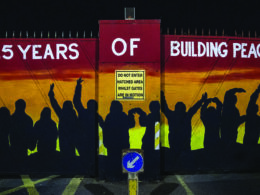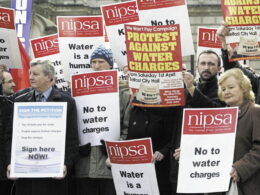By Peter Hadden
THE NORTHERN Ireland European election results have placed a huge question mark over the long term future of the Assembly. The crestfallen faces of DUP supporters at the count said all that needed to be said about the impact of the vote for Jim Allister and his Traditional Unionist Voice.
Ever since they overtook their Ulster Unionist rivals, the proudest boast of the DUP has been that they are the largest party in Northern Ireland. Their election literature urged a vote for their candidate, Diane Dodds, as “the only unionist who can stop Sinn Fein from topping the poll.” Not only did she fail to prevent Sinn Fein coming first, she herself only scraped in in third place, behind Jim Nicholson of the Ulster Unionists
Compared to the last euro election the DUP vote has almost exactly halved – they got 175,761 votes (32%) in 2004 and 88,346 (18%) this time. The missing votes were taken by Allister, who ran on a “no terrorists in government ticket” targeting disgruntled DUP voters and who polled a significant 66,000 votes, 13.9% of the total.
Low turnout
Because he cut such a swathe into the DUP votes, Allister grabbed all the post-election headlines. However the single most significant aspect of the election was not his vote. It was the fact that so few people bothered to vote at all. The turnout was 42.8%, almost 9% down on 2004 and historically low by Northern Ireland standards. The 489,000 who cast their votes were dwarfed by the 753,000 registered voters who stayed at home.
The lowest turnout was in working class areas and, in particular, in Protestant working class areas. Working class voters are disillusioned by the right wing economic policies of the Assembly and are enraged and disgusted by the double jobbing, nepotism and sleaze that characterises politics at Stormont, as at Westminster.
The low poll in Protestant working class areas puts the Allister campaign in a truer perspective. He did not generate enough enthusiasm or interest to encourage working class people to turn out in any significant numbers.
While the DUP were the main overall losers, none of the major parties can take any comfort from the result. Sinn Fein only topped the poll courtesy of the three-way split in unionism. 18,000 fewer people voted for them this time than in 2004.
Similarly with the Ulster Unionists, now renamed the Ulster Conservative and Unionist Party New Force (UCUNF), and the SDLP, both of whom saw their total vote fall.
The result has given all these parties a collective headache because it has placed the long-term future of the power sharing Executive – and of the Assembly – in question. In the next two years elections are due to Westminster, to the revamped local councils and to the Assembly.
As soon as his euro result was declared, Jim Allister announced that he would stand in the Westminster election against Ian Paisley Junior, the likely DUP candidate for the North Antrim seat that Paisley Senior has held since 1970. The media pictures of a very glumfaced Ian Paisley Junior at the count sums up the impact this can have on the DUP. A repeat of the euro results in an Assembly election would mean that Sinn Fein, as the largest party, would take the First Minister position with the DUP reduced to nominating a deputy.
Realignment of Unionism?
For the Assembly to survive the DUP would need to recover some of their vote or else there would have to be a realignment within unionism, something made more difficult by the link up between the Ulster Unionists and the Tories. The DUP may do what comes most natural – whip up sectarianism in order to regain support. However, if they choose this course, and at the same time stay in government with Sinn Fein, the most likely winner will be Allister’s TUV. Their other hope might be that dissident republicans could eventually do to Sinn Fein what Allister has done to them. But this would just mean that that it could be the crisis in Sinn Fein that could precipitate a collapse of the Assembly.
The right wing policies being carried out by all the Executive parties, especially the massive cuts in services and public sector jobs, make it more likely that all of them will continue to haemorrhage support.
More than anything else, what the election showed was the huge political vacuum that has opened up. There is anger and disgust at all the major parties. This creates a unique opportunity for the building of a new mass political force to represent the united interests of working class people. But it also creates dangers. Sooner or later some forces will emerge to fill the growing political vacuum. The danger is that if it is not filled by the left, it will be right wing and more extreme sectarian organisations that benefit – people like Allister on the one side and some amalgam or development of the various dissident republican groups on the other.
The emergence of any of these forces would be a major set back for the working class movement and would point to the opening of a new and more viciously sectarian phase of the Troubles.
There is time between now and the next round of elections for an initiative to bring together trade unions, genuine community organisations and socialists to discuss building a new political force that could field candidates in these elections and provide a socialist alternative to the dead end of sectarian and right wing politics.












